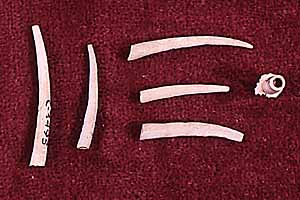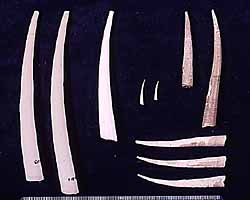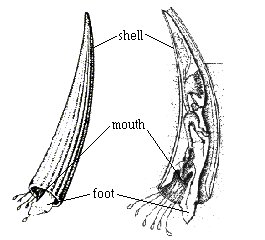 |
 |
The Scaphopoda are a distinctive group of molluscs commonly known as the "tusk shells" because their shells are conical and slightly curved to the dorsal side, making the shells look like tiny tusks (see the photos below). The scientific name Scaphopoda means "shovel foot", a term that refers to the "head" of the animal, which lacks eyes and is used for burrowing in marine mud and sediments. The most distinctive feature of scaphopods is that the tubular shell is open at both ends, not just one end as in most molluscs.
Scaphopods live their adult lives buried in sand or mud, with their head-end pointed downwards. Only the narrow posterior end of the shell sticks up into the seawater for water exchange and waste expulsion. Gills have been lost in the scaphopods, so the mantle tissue not only produces the shell, but also serves the function of gills in obtaining oxygen from seawater. The mantle is fused into a tube that surrounds the body of the animal, but it is open at both ends. Water is circulated around the mantle cavity by the action of numerous cilia. When the dissolved oxygen runs low, the water is ejected through the top end of the shell by contraction of the foot.
 |
 |
Scaphopods past and present : At left, above, is a collection of fossil scaphopod shells from the Miocene of Baluchistan, Pakistan. A fragmentary shell can be seen end-on at the right side of the image. The image at right displays five living species in the genus Dentalium. Clockwise from left: two Dentalium vernardi, collected at a depth of 40 fathoms off Kii on the island of Honshu, Japan; D. yokoyamai, collected at a depth of 100 fathoms off the island of Shikoku, Japan; D. indianorum (the two tiny shells), from the Strait of Fuca off Vancouver Island, British Columbia; two shells of D. solidum and three shells of D. meridionale, all collected off Block Island, Rhode Island, USA. (Click on either of the pictures above for a larger image).
Adult scaphopods move and search for food with their buried head. To do this, the animal extends its muscular foot outwards, then expands a muscled disc that surrounds the far end of the foot. Once the disc is spread out, it will serve as an anchor for the scaphopod to pull against.
 The head itself is not very conspicuous. There are tiny sense organs called
statocysts with which food can be detected, but otherwise no trace
of eyes or other features normally associted with a head. Threadlike
cilia-bearing tentacles (known as captacula) probe for food, such as
forams, detritus, and even the occasional
buried bivalve, and bring
it to the mouth where a large radula grinds it up.
The head itself is not very conspicuous. There are tiny sense organs called
statocysts with which food can be detected, but otherwise no trace
of eyes or other features normally associted with a head. Threadlike
cilia-bearing tentacles (known as captacula) probe for food, such as
forams, detritus, and even the occasional
buried bivalve, and bring
it to the mouth where a large radula grinds it up.
Adult scaphopods are either male or female. The female releases her eggs one at a time, and one hatching the young animal will go through both a free-swimming trochophore and veliger stage, like all molluscs, before settling into an adult form in the muddy seafloor. Adults may live at depths of 4570 meters.
The oldest fossil scaphopods have been found in Devonian rocks, and are assigned to the genera Plagioglypta and Prodentalium. Some Ordovician fossils have been described as possibly older scaphopod fossils, but these may also be pteropods (a group of gastropods) or the fossilized remains of worm burrows. Part of the problem is that the oldest known fossils of tusk shells have little surface detail. They tend to be smooth, and do not have the slight curvature that characterizes later fossils of the Mesozoic and Cenozoic. By the Cretaceous, fossils with well-defined longitudinal ridges appear, as in modern species of Dentalium and its close relatives (Family Dentaliidae).
Despite their unusual features, it is generally believed that the closest relatives of scaphopods are the bivalves. Like scaphopods, bivalves have a retractile foot which they use to burrow. They also share the reduced head and attachment pattern to their shell. Others have pointed out certain similarities to the gastropoda, or have suggested that scaphopods derive from the extinct rostoconchs. There are anywhere from 750 to 1200 species of scaphopod, with about half that number including the extinct species and the other half recent ones.
Shells of the genus Dentalium were once used in necklaces and as money (often termed "wampum") by Amerinds of the Pacific northwest from Alaska to California. The shells were collected on strings, and could be worn or hung.
For more information about scaphopods:
See the Mollusca page on the Tree of Life for information about scaphopod relationships.

Sources:

